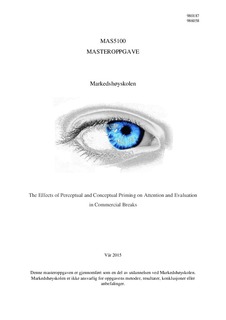The Effects of Perceptual and Conceptual Priming on Attention and Evaluation in Commercial Breaks
Abstract
While a vast number of studies have examined the effect of priming on positive evaluation towards an object, little research has been done on its effect on attention. Priming’s effect on positive evaluation has generally been attributed to an increase in associational availability that results in easier mental processing. This ease of mental processing is known as fluency. Furthermore, the theoretical review reveals that fluency, attention and emotional responses are highly interconnected. In this thesis, the priming paradigm is applied to a novel context; a sequence of video commercials. By manipulating the relatedness of two commercials, we examine whether a commercial can influence advertising effectiveness in the form of attention and increased positive evaluation towards product exposures in another commercial. This research involves collecting data from three groups, two of which are manipulated by different kinds of primes, and one which acts as control group. The commercial that the dependent variables are measured upon is known as the target commercial, and shown last in the sequence. The first group is exposed to a stimulus that is physically alike to the target commercial (perceptual prime). The second group is exposed to a stimulus that is only associatively alike (conceptual prime). Establishing the distinctions of these prime’s effect on attention was an important aspect of this paper. We predicted that the product in the target commercial should be more noticeable, and that attention would be paid to the product for a longer time. Furthermore, we predicted an increased positive evaluation of the target commercial and increased emotional arousal, both of which are connected. Data was collected both implicitly in the form of eye tracking measures, and explicitly through a questionnaire. The results suggest that the product attracts attention for a significantly longer time for the conceptual group. Furthermore, perceptual priming increases explicit positive evaluation. However, neither forms of priming makes the viewers notice the product exposures easier, nor elicit any substantial emotional arousal. The results are discussed in light of previous research on the topic of priming, fluency, attention and positive evaluation.
